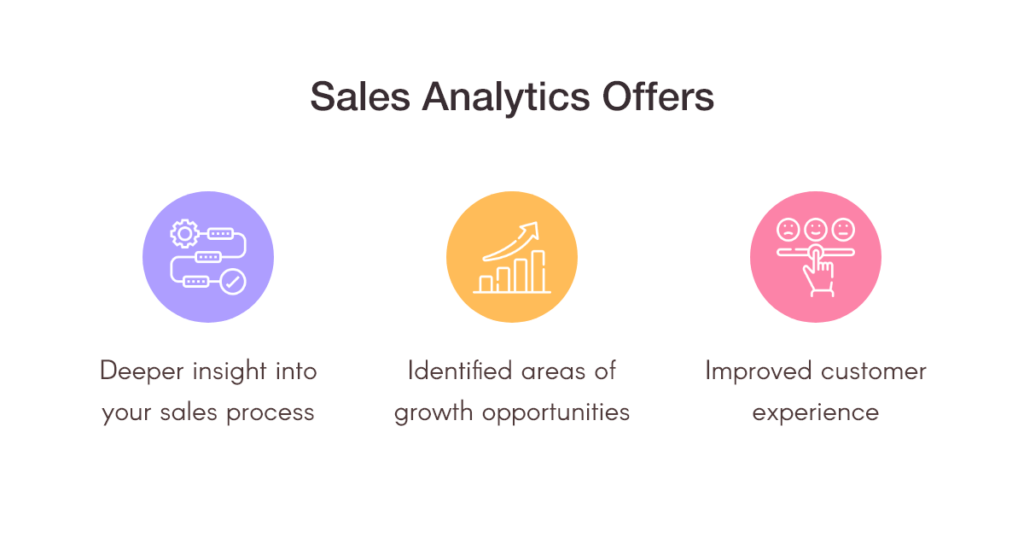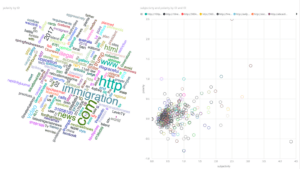Gartner defines Sales analytics as a process that identifies, model, understand, and predict sales trends and outcomes.
The sales function of organizations traditionally relied on the instincts and due diligence of the sales team. However, businesses are now banking heavily on data-driven insights to make all the critical business decisions.
This data enables the decision-makers and, consequently, the sales manager and representatives with relevant information about their prospects’ behavior and intent.
Insights derived from the sales data help an organization with-
- Goal setting
- Crafting an effective sales strategy
- Capture quality leads
- Retain existing clients and cross-sell/upsell
- Identifying key trends and new opportunities
- Forecasting the outcomes
Why join the Sales Analytics bandwagon?
Business Expansion, Increased Accountability, Accelerated Sales
Your business can achieve this and a lot more by investing in Data Analytics. Sales data can be gathered from a lot of sources, including
- Customer interaction with sales reps.
- Your website, CRM, sales tools, revenue intelligence platforms, online meeting platforms, email marketing, and Google and Facebook analytics.
- Social media platforms and online communities, including posts, remarks, likes, shares, and hashtags.
Analyzing the sales data using machine learning and BI tools can help accelerate the performance of your sales team. Sales Analytics derives actionable insights from this colossal data and improves the decision-making of the sales leadership.

Sales Analytics is primarily categorized as –
1. Predictive Analytics– This answers the question “what is likely to happen?” It scrutinizes your past data, such as revenue, deal size, time, as well as sales trends and models to forecast future sales.
2. Prescriptive Analytics– Once you have the sales forecast from predictive analytics, you need to come up with a suitable plan of action to ensure that all your goals are met.
3. Diagnostic Analytics– This is used when you need to reach the root cause of a particular issue.
4. Descriptive Analytics– Enables the tracking of previous sales data—revenue, user count, and so on. It allows you to compare trends and discover what is happening right now.
Why should companies invest in Sales Data Analytics?
1. Targeted customer interactions
Armed with relevant information, the sales reps can personalize the value proposition of your products based on your customer’s requirements. This results in building trust and rapport with your prospects.
The system also monitors the content flow and usage used in client communications. This provides the sales reps with repeatable, reliable material that allows for iterations and changes in the sales content.
Data Analytics also helps the marketing team identify the target market, and pitch the product effectively while using the right communication channels – be it email marketing, social media, or other outreach options.
Read our blog – Power Your Marketing With Data Analytics
2. Unleashes new Lead-gen opportunities
Insights that you derive from high-quality sales data can help you discover the purchase intent of your prospects. It enables the sales rep to nurture and build relationships with the prospects that are more likely to convert.
Sales analytics tools enable a comparison of your prospects with your previous customers. This helps the sales team segment the pipeline leads based on their engagement level.
3. Ensures customer retention
Research indicates that retaining customers is five to twenty-five times more economical vis-a-vis acquiring new customers. It also shares that building a rapport with a new customer is 16 times harder.
Another research from Bain and Company showcased that existing customers will spend 67% more vis-a-vis new customers.
The sales team should not only be aware of who are your biggest customers currently, but also identify the customers who have the potential to increase the business account. Sales data and related insights can assist them in this.
All their communications and efforts should be directed to ensure that these priority customers are happy with your company’s offerings. The sales rep should also make dedicated efforts to upsell and cross-sell to the existing customers.
4. Optimize Team’s Performance
Analytics and insights to empower sales managers! They can now make sales forecasts for their team members based on their past performance and future pipeline.
It is also used to identify inefficiencies and productivity gaps in your sales process. Conversation Analytics plays a vital role here. It derives information from the sales transcripts and parameters including Talk ratio, monologues of the sales rep as well as customer, interactivity, etc to accelerate the sales process and address the inadequacies.
Measure and Fix with KPIs
How would you measure the effectiveness of your sales analytics process?
How will you maneuver the efforts of your sales team to achieve desired results?
If you are leveraging data analytics to accelerate your sales, we recommend using the following KPIs to measure your success.
1. Revenue Growth
The most direct indicator that addresses the bottom line! Any deviation from the predicted numbers instantly leads to corrective measures.
| Annual Recurring Revenue = Order value/ Contract duration in years |
2. Sales Target
This KPI measures current performance with the determined business goal. Sales can be denoted as direct revenue or other parameters such as the number of customers, quantity sold, and so on.
3. Average Revenue per Account
This calculates the revenue generated by a product, service, account, or customer. This metric is important if your company is excessively dependent on a small number of major accounts. You would need to focus on onboarding new clients to reduce this dependency.
| Average Revenue per Account = Total revenue/ Number of (Accounts/ products/ service) |
4. Market Share
Market share indicates how your company is performing concerning the projected growth. Businesses typically compare this to their total addressable market (TAM), which is an estimate of the size of a particular market for a good or service.
| Market Share = Total Revenue / Total Addressable Market |
5. Lead to Opportunity Conversion Ratio
This metric indicates the percentage of leads that convert into substantial opportunities. If the ratio is very low, the sales leaders need to measure the effectiveness of lead generation activities.
6. Opportunities to Sales Conversion rate
Identify the effectiveness of your sales team with this KPI and discover improvement areas.
7. Length of the Sales Cycle
- Measure the number of days it takes to convert a lead into order.
- Find areas of improvement
- Identify employees who are taking longer to close deals and coach them
- Reward and recognize the best performers
8. Key Sales Activity
This metric includes tracking the number of outreach – calls, emails, and meetings achieved by a sales rep.
9. Sales Pipeline
- Length of the sales cycle
- Open opportunities
- Closed opportunities
- Value of the pipeline
- Value of sales
- Average contract value (ACV)
- Win rate
- Conversion rate
Parting Words –
Data analytics is what you need to accelerate your sales and make data-driven decisions. Get in touch with us if you need help in managing, analyzing, and drawing actionable insights from your sales data.




